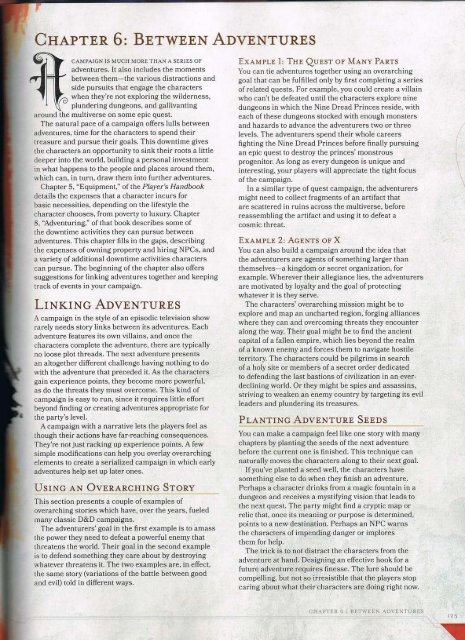Dungeon Master's Guide
You also want an ePaper? Increase the reach of your titles
YUMPU automatically turns print PDFs into web optimized ePapers that Google loves.
CHAPTER 6: BETWEEN ADVENTURES<br />
CAMPAIGN IS MUCH MORE THAN A SERIES OF<br />
adventures. It also includes the moments<br />
between them-the various distractions and<br />
side pursuits that engage the characters<br />
when they're not exploring the wilderness,<br />
plundering dungeons, and gallivanting<br />
around the multiverse on some epic quest.<br />
The natural pace of a campaign offers lulls between<br />
adventures, time for the characters to spend their<br />
treasure and pursue their goals. This downtime gives<br />
the characters an opportunity to sink their roots a little<br />
deeper into the world, building a personal investment<br />
in what happens to the people and places around them,<br />
which can, in turn, draw them into further adventures.<br />
Chapter 5, "Equipment," of the Player's Handbook<br />
details the expenses that a character incurs for<br />
basic necessities, depending on the lifestyle the<br />
character chooses, from poverty to luxury. Chapter<br />
8, "Adventuring," of that book describes some of<br />
the downtime activities they can pursue between<br />
adventures. This chapter fills in the gaps, describing<br />
the expenses of owning property and hiring NPCs, and<br />
a variety of additional downtime activities characters<br />
can pursue. The beginning of the chapter also offers<br />
suggestions for linking adventures together and keeping<br />
track of events in your campaign.<br />
LINKING ADVENTURES<br />
A campaign in the style of an episodic television show<br />
rarely needs story links between its adventures. Each<br />
adventure features its own villains, and once the<br />
characters complete the adventure, there are typically<br />
no loose plot threads. The next adventure presents<br />
an altogether different challenge having nothing to do<br />
with the adventure that preceded it. As the characters<br />
gain experience points, they become more powerful,<br />
as do the threats they must overcome. This kind of<br />
campaign is easy to run, since it requires little effort<br />
beyond finding or creating adventures appropriate for<br />
the party's level.<br />
A campaign with a narrative lets the players feel as<br />
though their actions have far-reaching consequences.<br />
They're not just racking up experience points. A few<br />
simple modifications can help you overlay overarching<br />
elements to create a serialized campaign in which early<br />
adventures help set up later ones.<br />
USING AN 0VERARCHING STORY<br />
This section presents a couple of examples of<br />
overarching stories which have, over the years, fueled<br />
many classic D&D campaigns.<br />
The adventurers' goal in the first example is to amass<br />
the power they need to defeat a powerful enemy that<br />
threatens the world. Their goal in the second example<br />
is to defend something they care about by destroying<br />
whatever threatens it. The two examples are, in effect,<br />
the same story (variations of the battle between good<br />
and evil) told in different ways.<br />
EXAMPLE 1: THE QUEST OF MANY PARTS<br />
You can tie adventures together using an overarching<br />
goal that can be fulfilled only by first completing a series<br />
of related quests. For example, you could create a villain<br />
who can't be defeated until the characters explore nine<br />
dungeons in which the Nine Dread Princes reside, with<br />
each of these dungeons stocked with enough monsters<br />
and hazards to advance the adventurers two or three<br />
levels. The adventurers spend their whole careers<br />
fighting the Nine Dread Princes before finally pursuing<br />
an epic quest to destroy the princes' monstrous<br />
progenitor. As long as every dungeon is unique and<br />
interesting, your players will appreciate the tight focus<br />
of the campaign.<br />
In a similar type of quest campaign, the adventurers<br />
might need to collect fragments of an artifact that<br />
are scattered in ruins across the multi verse, before<br />
reassembling the artifact and using it to defeat a<br />
cosmic threat.<br />
ExAMPLE 2: AGENTS OF X<br />
You can also build a campaign around the idea that<br />
the adventurers are agents of something larger than<br />
themselves-a kingdom or secret organization, for<br />
example. Wherever their allegiance lies, the adventurers<br />
are motivated by loyalty and the goal of protecting<br />
whatever it is they serve.<br />
The characters' overarching mission might be to<br />
explore and map an uncharted region, forging alliances<br />
where they can and overcoming threats they encounter<br />
along the way. Their goal might be to find the ancient<br />
capital of a fallen empire, which lies beyond the realm<br />
of a known enemy and forces them to navigate hostile<br />
territory. The characters could be pilgrims in search<br />
of a holy site or members of a secret order dedicated<br />
to defending the last bastions of civilization in an everdeclining<br />
world. Or they might be spies and assassins,<br />
striving to weaken an enemy country by targeting its evil<br />
leaders and plundering its treasures.<br />
PLANTING ADVENTURE SEEDS<br />
You can make a campaign feel like one story with many<br />
chapters by planting the seeds of the next adventure<br />
before the current one is finished. This technique can<br />
naturally moves the characters along to their next goal.<br />
If you've planted a seed well, the characters have<br />
something else to do when they finish an adventure.<br />
Perhaps a character drinks from a magic fountain in a<br />
dungeon and receives a mystifying vision that leads to<br />
the next quest. The party might find a cryptic map or<br />
relic that, once its meaning or purpose is determined,<br />
points to a new destination. Perhaps an NPC warns<br />
the characters of impending danger or implores<br />
them for help.<br />
The trick is to not distract the characters from the<br />
adventure at hand. Designing an effective hook for a<br />
future adventure requires finesse. The lure should be<br />
compelling, but not so irresistible that the players stop<br />
caring about what their characters are doing right now.<br />
(<br />
\<br />
CHAPTER 6 I BETWEEN ADVENTURES<br />
125




